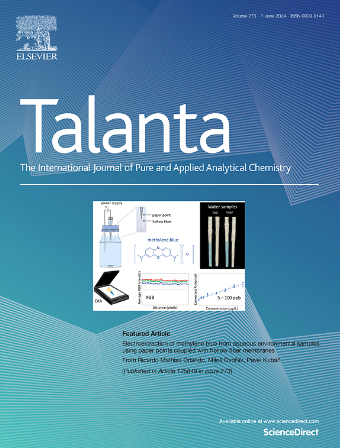A novel and universal dual-channel signal amplification aptasensing platform for ultrasensitive and rapid detection of cardiac biomarkers based on the mutual regulation of bimetallic organic framework and silver nanoclusters
IF 5.6
1区 化学
Q1 CHEMISTRY, ANALYTICAL
引用次数: 0
Abstract
Cardiac troponin I (cTnI) is a key biomarker for diagnosing myocardial infarction caused by myocardial injury. The accurate and rapid monitoring of ultralow levels of cTnI is crucial for early diagnosis and risk warning of myocardial injury. Herein, a novel dual-channel signal amplification aptasensor for cTnI detection was developed utilizing the mutual regulation of bimetallic organic framework (MOFs) and silver nanoclusters (AgNCs) with the assistance of catalytic hairpin assembly (CHA). Rationally designed triple-helix molecular switch (THMS) and two hairpin probes (HP1 and HP2) containing AgNCs and a guanine-rich DNA sequence could be adsorbed onto the surface of bimetallic Cu, Mo-MOFs, enhancing the catalytic activity and reducing the fluorescence signal. The target cTnI specifically binds to the aptamer in the THMS, releasing the signal transduction probe which triggers CHA to desorb HP1–AgNCs and HP2, thereby restoring the fluorescence and decreasing the catalytic activity as well as initiating cycling. This enables dual-channel fluorescence and colorimetric detection of cTnI. The linear fluorescence and colorimetric response ranges were 0.001–20 ng/mL with LOD of 0.48 pg/mL and 0.001–10 ng/mL with LOD of 0.69 pg/mL, respectively. The aptasensor significantly increases the detection sensitivity and reduces the time required for cTnI detection in human serum, with excellent anti-interference capability. Moreover, the aptasensor shows promise for the construction of universal dual-channel aptasensors for multiple targets by altering the aptamer in THMS.

求助全文
约1分钟内获得全文
求助全文
来源期刊

Talanta
化学-分析化学
CiteScore
12.30
自引率
4.90%
发文量
861
审稿时长
29 days
期刊介绍:
Talanta provides a forum for the publication of original research papers, short communications, and critical reviews in all branches of pure and applied analytical chemistry. Papers are evaluated based on established guidelines, including the fundamental nature of the study, scientific novelty, substantial improvement or advantage over existing technology or methods, and demonstrated analytical applicability. Original research papers on fundamental studies, and on novel sensor and instrumentation developments, are encouraged. Novel or improved applications in areas such as clinical and biological chemistry, environmental analysis, geochemistry, materials science and engineering, and analytical platforms for omics development are welcome.
Analytical performance of methods should be determined, including interference and matrix effects, and methods should be validated by comparison with a standard method, or analysis of a certified reference material. Simple spiking recoveries may not be sufficient. The developed method should especially comprise information on selectivity, sensitivity, detection limits, accuracy, and reliability. However, applying official validation or robustness studies to a routine method or technique does not necessarily constitute novelty. Proper statistical treatment of the data should be provided. Relevant literature should be cited, including related publications by the authors, and authors should discuss how their proposed methodology compares with previously reported methods.
 求助内容:
求助内容: 应助结果提醒方式:
应助结果提醒方式:


